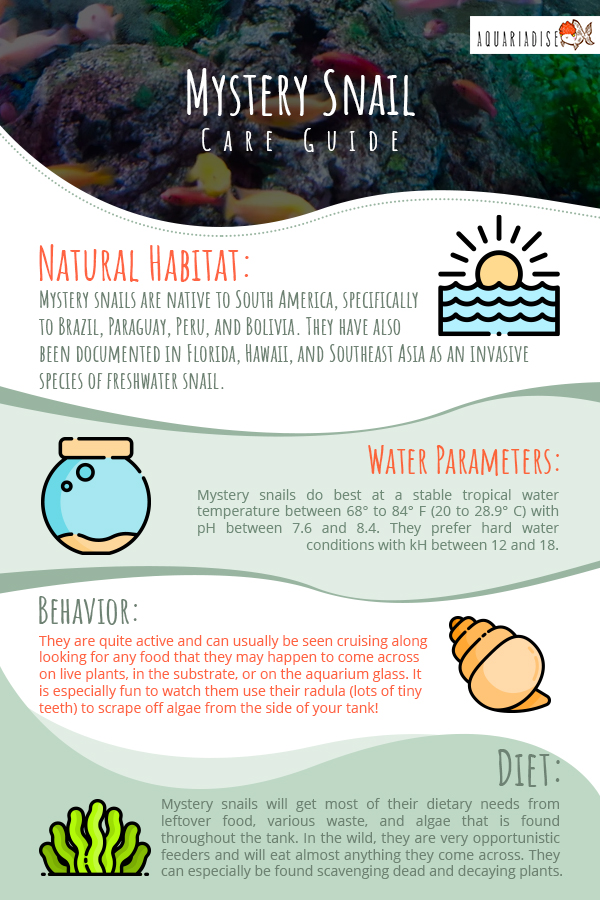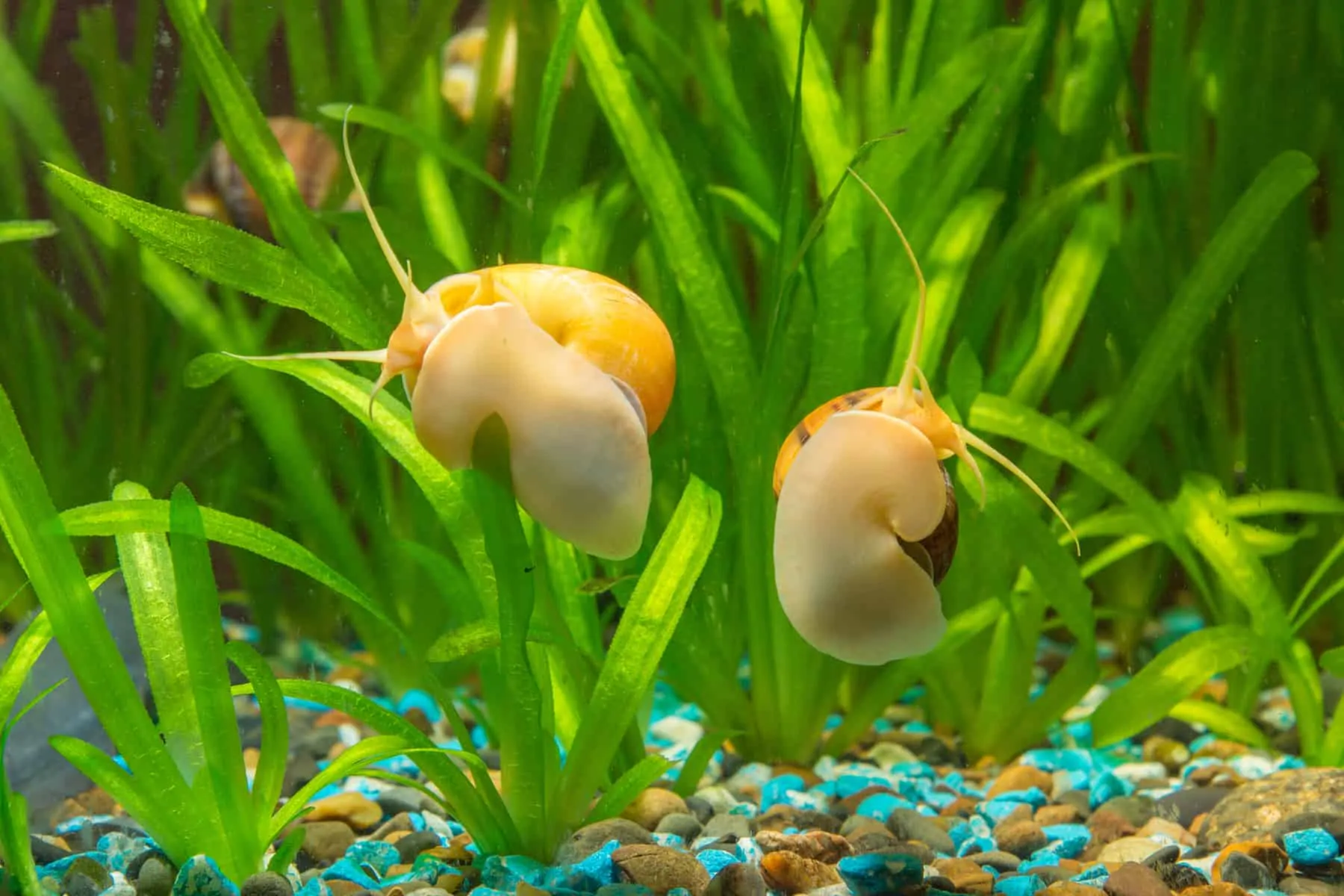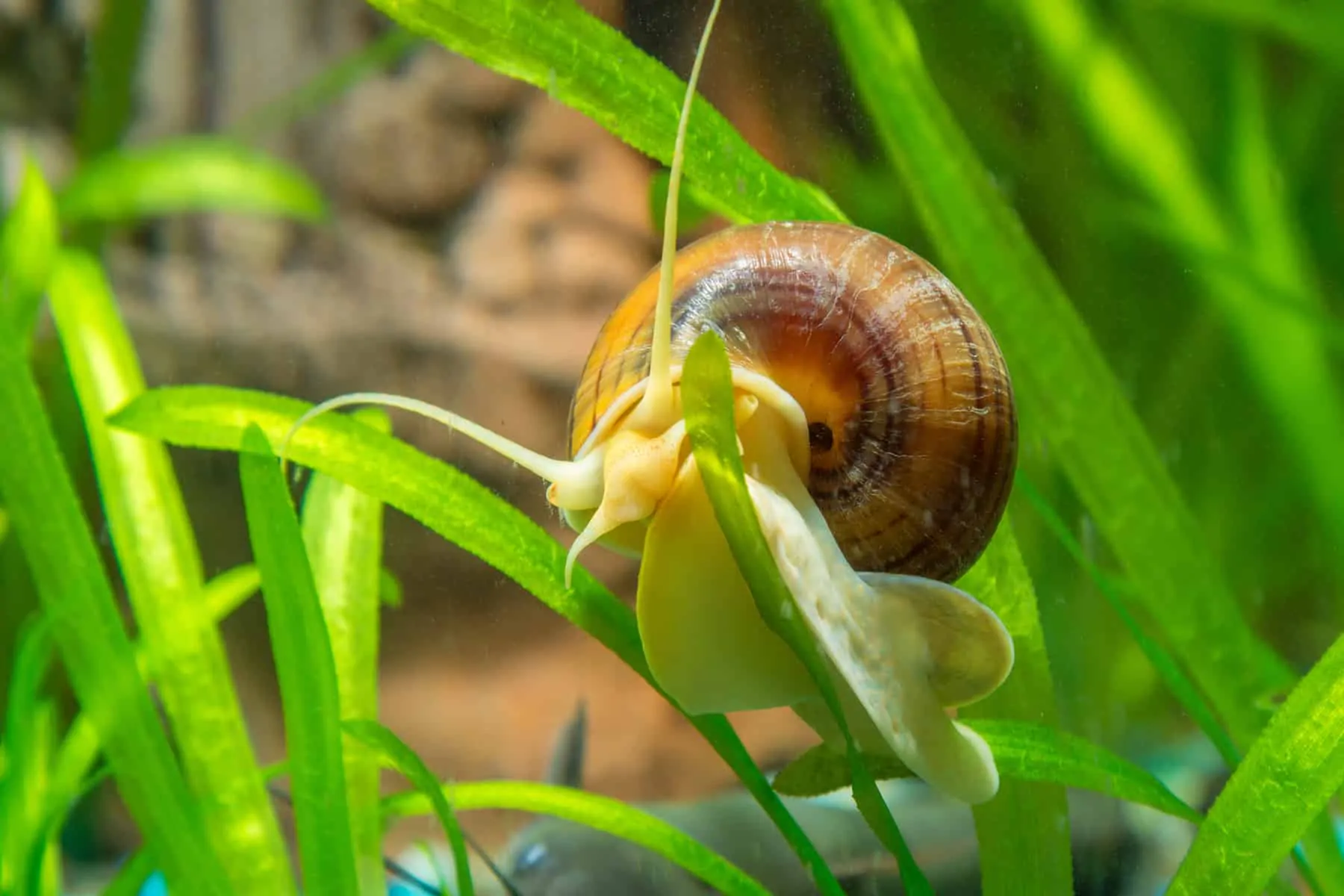Does your freshwater fish tank have a nice green hue to its glass? Are your algae eaters more interested in something other than the algae they’re supposed to be eating? Perhaps the simple solution is adding some mystery snails to your cleanup crew!
These snails make a great peaceful addition to any aquarium struggling with algae or detritus and come in a variety of colors that really pop. Mystery snails are plant-safe and don’t require any special care as long as they are placed in a community tank.
Keep reading to find out everything you need to know about mystery snail care and keeping these freshwater snails in your own aquarium.

Name
Mystery snails are widely accepted as members of the Pomacea genus, specifically Pomacea bridgesii. Mystery snails may also be referred to as the spike-topped apple snail with different color varieties having their own designated names.
The mystery snail is part of the Ampullariidae family and may be widely labeled as apple snails as a whole. However, true apple snails grow very large and are actually illegal to own in some areas due to being a highly invasive species. Make sure that your mystery snail is a member of Pomacea bridgesii so that you don’t end up with an oversized aquarium snail!
Two well-known subspecies of Pomacea bridgesii are Pomacea bridgesii bridgesii and Pomacea bridgesii diffusa.
Why are mystery snails called mystery snails?
There are a few myths behind the name ‘mystery snail.’ Some hobbyists believe that they earned this name due to their ability to completely disappear from a tank for a few days at a time and then reappear as if they never went missing. Others think that their name is due to their ability to quickly reproduce, and mysteriously going from one snail to a tank filled with mystery snails overnight.
Some other origins of the ‘mystery snail’ name date back to the introduction of similar species (Cipangopaludina japonica and Cipangopaludina chinensis) to the United States from their native waters in East Asia. Since the species was not recognized, it was given the general ‘mystery snail’ name that has since stuck around in the aquarium trade. This article will only discussspecies of Pomacea.

Natural habitat
Mystery snails are native to South America, specifically to Brazil, Paraguay, Peru, and Bolivia. They have also been documented in Florida, Hawaii, and Southeast Asia as an invasive species of freshwater snail.
In the wild, mystery snails will often hide in areas with dense vegetation, like swamps, ponds, and other slow-moving waterways. They will stay in the vegetation during the day and emerge at night to find food. These snails actually have both gills and lungs, so they will regularly emerge from the water to graze on algae and other vegetation. When they are underwater, they will extend the siphon from their head to collect water to pass through their gills.
Identification
Invertebrates are just as important to be able to identify as fish are and snails can be a little tricky to tell apart at first. Mystery snails are one of the largest freshwater snails and can measure more than 2 inches (5 cm) across their shells, though they are more likely to stay under 1.5 inches (3.8 cm) on average.
Their shells are smooth and rounded with a typical whorl and apex snail anatomy. On top of the variety of colors that their shells come in, mystery snails also have an iridescent patterning to their bodies that really makes them a beautiful part of the cleanup crew.
Here are some color variations you’re likely to run into:
Gold/Golden mystery snails. You may see these snails listed as gold or golden. This variation has a striking yellow and gold shell with an iridescently speckled pearly body.
Albino mystery snails. Albino mystery snails surprisingly don’t have white shells, however, they do have a white pearly body with iridescent flakes similar to those of the gold/golden mystery snail. Their shells are often striped with shades of browns and off-whites.
Black mystery snails. These snails are more common and are a little more difficult to correctly identify as their shells can range in color. Some shells can resemble those of albino shells and can have shades of anything between black and purple and can be striped with lighter colors. They can be distinguished by their bluish-grey bodies, which can have speckles of iridescent oranges.
Other variations. Other uncommon colors you may come across are blue, ivory, and olive jade.
Mystery snail tank requirements
Mystery snails don’t require a lot of special care, though there are some tank parameters that will help ensure your snail lives a happy and healthy life. They are a pretty hardy species but are especially susceptible to sudden water changes.
It is best to keep your mystery snail in an aquarium with plenty of live plants. They will not eat the plants unless other food sources become scarce. They will also help clean up any live plants in your tank that have partially died or completely died.
Mystery snails do best at a stable tropical water temperature between 68° to 84° F (20 to 28.9° C) with pH between 7.6 and 8.4. They prefer hard water conditions with kH between 12 and 18.
While the mystery snail may look small, they are known to reproduce fast and produce a considerable amount of waste in the aquarium. Because of this, the recommended tank size is one snail per every 5 to 10 gallons (18.9 to 37.9 L) of water to ensure water quality and to help prevent a massive mystery snail population in your tank.
Since mystery snails can breathe air, you will often find them above the water line of your tank, especially when the aquarium light is off. Make sure that you have a dependable tank lid that won’t make it easy for your snail to escape. Also, make sure that you don’t make the water line of your tank too high so that there is space for your mystery snail to explore, find food, and possibly lay eggs.
Mystery snails do not require any special aquarium substrate and can easily move across gravel and sand alike; gravel may just provide more surface area for algae to grow and serve as another source of natural food.
Other water conditions
Like all other species of snail, mystery snails are especially susceptible to any traces of copper that may enter the aquarium. Always check the ingredients of any chemicals you introduce into the tank as copper will quickly kill any freshwater aquarium invertebrates.
It is also important to keep a close eye on the pH levels in your tank. Not only will fish and live plants suffer, but your mystery snails will also not be able to handle too acidic or too basic levels. Low pH will actually start to dissolve invertebrates shells and exoskeletons and can lead to them cracking or becoming too thin.
Cracked or thin snail shells may also be due to the calcium levels in your tank. Mystery snails use calcium to help grow and strengthen their shells; unlike hermit crabs, snails cannot leave their shells and are actually growing them all the time. It would be worthwhile to pick up a freshwater aquarium testing kit and calcium supplements if you have a lot of invertebrates in your tank.
Mystery snail behavior
Mystery snails are perfect for a community tank and can only help make your freshwater aquarium a more healthy and sustainable mini-ecosystem if done right. They are quite active and can usually be seen cruising along looking for any food that they may happen to come across on live plants, in the substrate, or on the aquarium glass. It is especially fun to watch them use their radula (lots of tiny teeth) to scrape off algae from the side of your tank!
If they feel threatened, they will retract into their shell and cover their body with their hardened operculum. When purchasing your mystery snail, make sure that it is actively roaming the tank and that the operculum is not missing. A healthy snail will either be completely in or out of its shell; one that is halfway out is most likely injured or dying.
Are mystery snails good for your tank?
Mystery snails can do amazing things for a freshwater fish tank and won’t bother other fish or plant tank mates. They clean up leftover food and fish waste and bring a splash of color to the aquarium. They are also sometimes used for their ability to maintain and eradicate some nuisance algae, such as hair algae, but are more so appreciated for scraping various film algae.
As your mystery snails cruise across your substrate and climb up and down your plants, they will help overturn these areas and bring in fresh water just like terrestrial worms do in the soil. Mystery snails are usually preferred over other aquarium snails as they are large enough to be found if problems do arise. As we’ll discuss later, they tend to multiply very quickly and their population within the aquarium will need to be managed.
However, because mystery snails are so big, there is always the possibility that they can cause water quality issues. The bigger the mystery snail, the more waste it is likely to produce. And since these snails are almost constantly eating something in the tank, they’re likely to create a lot of waste on a day-to-day basis.
The real problem, though, can be if your mystery snail disappears and turns out having died. Like freshwater clams, dead snails can also cause significant ammonia spikes if not immediately removed from the tank. If you notice that your snail is halfway out of its shell, remove it from the tank. You will know if it is alive or dead given the poignant smell of the latter. If the snail is alive, it should also retract into its shell once being handled.
Mystery snail tankmates
Mystery snails will get along with most tank mates that can also go in a community tank and will not bother any fish. While some hobbyists may advise against mystery snails if you have other bottom-dwelling fish in your aquarium, it should be no problem if you have a large enough tank and enough food is provided for both. You may see your snail retract into its shell if a fish comes too close, but as long as it is not constantly doing this, there should be plenty of other spots that your mystery snail could explore instead.
At the same time, these snails have a strong sense of smell and you may see them fearlessly side by side with the rest of your fish at the bottom of the tank when food is present.
Mystery snails will especially help with upper and middle water column-swimming fish. They will eat any leftover food that your other fish refuse to eat off the substrate as well as any other waste that makes its way to the bottom. Peaceful tank mates, like guppies, hatchetfish, swordtails, and tetras, will greatly appreciate a mystery snail helping to keep their tank clean!
Some hobbyists have also had success having their mystery snail be tank mates with their betta fish. While some bettas tend to be more aggressive and may nip at your snail’s siphon or antennae, a large enough tank, plenty of food, and lots of plants for hiding should be enough to keep both happy.
Large and active fish will not make good tank mates for mystery snails. Fish like oscars, cichlids, and puffers will definitely make a quick snack of your snail. Carnivorous invertebrates, like crayfish, should be avoided while shrimp, like cherry shrimp and Amano shrimp, will do just fine.
Mystery snails have no problem being kept with other mystery snails. Just remember that each snail will need at least 5 gallons (18.9 L) to itself.

Mystery snail diet
Mystery snails will get most of their dietary needs from leftover food, various waste, and algae that are found throughout the tank. In the wild, they are very opportunistic feeders and will eat almost anything they come across. They can especially be found scavenging dead and decaying plants.
While it is not necessary, planting some plants in your aquarium will provide your mystery snail with some extra food; algae will grow on top of the leaves and the plants will occasionally shed, leaving your snails with a small buffet of food to choose from!
Whether you choose to have plants in your aquarium or not, you will definitely see your snail scraping its way across the front of your tank; mystery snails will love any film algae they’re able to find on your aquarium substrate, rocks, driftwood, and glass. If your aquarium glass is especially dirty, you may be able to see a clearing in the wake of your snail where it has already eaten the algae.
While the chance of your mystery snail taking an interest in your plants is minimal, there is always the chance that they may take a nibble (or eat all of your plants overnight). As long as your snail is getting enough food, then there should be no problems.
If you find that your snail is eating your plants, try providing additional fish flakes and pellets, as well as algae wafers and blanched vegetables. Algae wafers are recommended as they give your snails the greens they need and sink to the bottom so that your snails have a chance to get to them.
Breeding mystery snails
Many people want to prevent baby snails from taking over their tank and not encourage mystery snails to breed. However, mystery snails can be a good source of protein for larger aquarium fish, like puffers and cichlids, and can be cultured for live food.
The secret to breeding these snails is that you don’t actually need to do anything for them to happily reproduce. When conditions are right, the female mystery snail will lay her eggs at or above the water surface; these eggs are easy to recognize and can be removed if not wanted.
If your water level is high and you want your mystery snail to lay eggs, try removing some water from the tank to make space.
There is a good chance that your baby snails will be eaten very quickly even by smaller fish, and only a few will make it to adulthood. You will most likely see them the most at night, covering the rocks and plants in your tank. Make sure to feed extra during these times to help them grow.
Can mystery snails reproduce on their own?
The mystery snail is not asexual and reproduction requires both a female and male snail. However, they are very likely to breed on their own in an aquarium without any needed intervention.
Buying mystery snails
Mystery snails are pretty easy to come by but are sometimes mislabeled as a different species of snail. They are easily found online if you have any doubts about the kind of snail your local fish store has listed.
Make sure to check the shell of the mystery snail you’re interested in. The color of both the shell and the snail body should be uniform and vibrant; do not buy a mystery snail that has a cracked shell (also flip the shell over to check if there is in fact a mystery snail in it or not). The snail should be moving around the tank and a decent size.
There is also the possibility that you may actually come across a snail that is missing an eye! While you should definitely see what else is available first, if you really want to rescue the snail then it should be no problem. These eye stalks are able to regenerate themselves and your snail will have two fully functioning eyes after a few weeks!
Conclusion
Mystery snail care is easy and straightforward. Provide a large enough tank with lots of natural plants and algae and wait for your snail to clean up the mess from your other fish. Keep the water level of your tank a little lower than the hood so your mystery snail has enough space to emerge and possibly lay eggs if you choose.
There are many different colors of mystery snail and available and each can bring a beautiful pop of color to your aquarium with no extra requirements!
If you have any questions about mystery snail care or have kept these snails in your own freshwater tank, don’t hesitate to leave a comment below!


